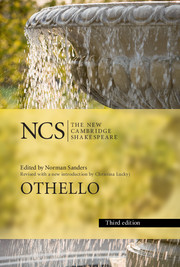Book contents
- The New Cambridge Shakespeare
- The New Cambridge Shakespeare
- Othello
- Copyright page
- Contents
- Illustrations
- Acknowledgements to First Edition
- Acknowledgements to Third Edition
- Abbreviations and Conventions
- Introduction
- Note on the Text
- Othello
- Supplementary Notes
- Textual Analysis
- Reading List
- References
Reading List
Published online by Cambridge University Press: 16 August 2019
- The New Cambridge Shakespeare
- The New Cambridge Shakespeare
- Othello
- Copyright page
- Contents
- Illustrations
- Acknowledgements to First Edition
- Acknowledgements to Third Edition
- Abbreviations and Conventions
- Introduction
- Note on the Text
- Othello
- Supplementary Notes
- Textual Analysis
- Reading List
- References
Summary

- Type
- Chapter
- Information
- Othello , pp. 234 - 239Publisher: Cambridge University PressPrint publication year: 2018

